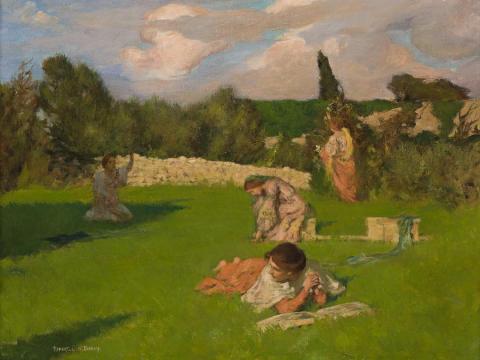SUMMER AFTERNOON, c.1890-91
RUPERT BUNNY
oil on canvas
48.0 x 64.0 cm
signed lower left: Rupert C.W. Bunny
Private collection, possibly the Molnar family, Hungary
Sotheby's, Sydney, 15 August 2000, lot 50
Collection of Lex Aitken and Alfredo (Bouret) Gonzalez, Sydney
Royal Society of British Artists, London, 1893, cat. 2 (as'A Summer Afternoon', £26.5.0)
Institute of Painters in Oil Colours, London (distressed label attached verso)
Edwards, D., Rupert Bunny: Artist in Paris, Art Gallery of New South Wales, Sydney, 2009, p. 48 (illus.)
During the last decade of the nineteenth-century, Rupert Bunny spent a rich and fruitful time in Hungary. He undertook portrait commissions, exhibited in the annual Spring International Exhibitions of the Hungarian National Fine Arts Society, and Pastorale, c1893, one of his most important early works, was bought by Baronne de Bánffy, wife of the then Prime Minister of Hungary, DezsőBaron Bánffy de Losoncz. Bunny first visited Hungary in the summer of 1889 as the guest of the People's Theatre Company, established by his friend Zsigmond Justh on the family's country estate at Pusztaszenttornya. Bunny and Justh met in Paris the year before, the gifted writer being a talented pianist and popular figure in the fashionable salons of Paris. He introduced Bunny to a glittering Parisian social world of the gifted, Sarah Bernhardt being but one of them. That same year Bunny painted Justh's portrait, which is now in the Museum of Literature Petöfi, Budapest.
On Bunny's second visit to Hungary in 1890, Justh wrote in the Magyar Bazár of Bunny coming 'here to us to paint'.1 Summer Afternoon is believed to be one of the works painted during this visit. This is supported by a letter Bunny wrote to Justh from Paris on 26 June 1891 in which he spoke of how greatly he enjoys his visits, saying he felt 'quite homesick for St Tornya'. Referring to 'sketches from St Tornya', which he sent to an exhibition, he added, 'I have put figures into each of them and made pictures'.2 Examination of Summer Afternoon shows that the figures have been added, demonstrated by the thicker overlay of the paint.
The model for the central figure is Jeanne-Heloise Morel, Bunny's future wife. A mood of languor envelops the scene as four women relax out-of-doors, seated, reading, gathering flowers. It is a variant on the favourite Bunny theme of the idyll, transferred from the shoreline peopled with mythological creatures to the open countryside as an image of contemporary life. Summer Afternoon provides a foretaste of those masterpieces of feminine charm and elegance of indolence, A Summer Morning, c1897 (Art Gallery of South Australia, Adelaide) and Dolce Farniente, c1897 (private collection), what Deborah Edwards referred to as 'Feminine Arcady'.3 It is redolent of the atmosphere of a European summer's day, of moments bathed in the light warmth of the sun and gentle breeze, suggesting a beauty that is timeless. Exhibited at the Royal Society of British Artists, London, 1893, together with A Sea Idyll and Bella Giovanna, the English critics admired Bunny's work for its individuality, especially its combination of imagination and realism as found in this painting.
1. Justh, Z.,'Egy Angool Festöröl', Magyar Bazár, Budapest, 1 June 1890, p. 86, translated by Eniko Hidas for the Art Gallery of New South Wales
2. Bunny to Justh, Paris, 26 June [1891], letters to Zsigmond Justh 1888-1893, Hungarian National Szechenyi Library, Budapest
3. Edwards, D., Rupert Bunny: Artist in Paris, Art Gallery of New South Wales, Sydney, 2009, p. 59
DAVID THOMAS
